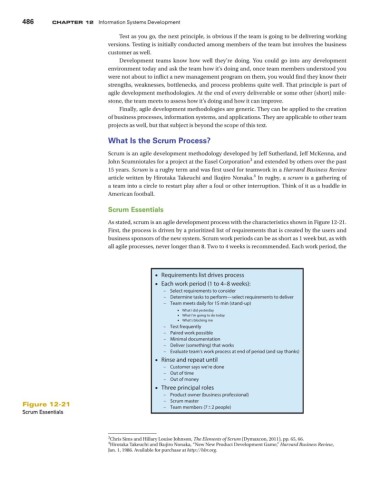Page 518 - Using MIS
P. 518
486 Chapter 12 Information Systems Development
Test as you go, the next principle, is obvious if the team is going to be delivering working
versions. Testing is initially conducted among members of the team but involves the business
customer as well.
Development teams know how well they’re doing. You could go into any development
environment today and ask the team how it’s doing and, once team members understood you
were not about to inflict a new management program on them, you would find they know their
strengths, weaknesses, bottlenecks, and process problems quite well. That principle is part of
agile development methodologies. At the end of every deliverable or some other (short) mile-
stone, the team meets to assess how it’s doing and how it can improve.
Finally, agile development methodologies are generic. They can be applied to the creation
of business processes, information systems, and applications. They are applicable to other team
projects as well, but that subject is beyond the scope of this text.
What Is the Scrum Process?
Scrum is an agile development methodology developed by Jeff Sutherland, Jeff McKenna, and
3
John Scumniotales for a project at the Easel Corporation and extended by others over the past
15 years. Scrum is a rugby term and was first used for teamwork in a Harvard Business Review
4
article written by Hirotaka Takeuchi and Ikujiro Nonaka. In rugby, a scrum is a gathering of
a team into a circle to restart play after a foul or other interruption. Think of it as a huddle in
American football.
Scrum Essentials
As stated, scrum is an agile development process with the characteristics shown in Figure 12-21.
First, the process is driven by a prioritized list of requirements that is created by the users and
business sponsors of the new system. Scrum work periods can be as short as 1 week but, as with
all agile processes, never longer than 8. Two to 4 weeks is recommended. Each work period, the
• Requirements list drives process
• Each work period (1 to 4–8 weeks):
– Select requirements to consider
– Determine tasks to perform—select requirements to deliver
– Team meets daily for 15 min (stand-up)
• What I did yesterday
• What I’m going to do today
• What’s blocking me
– Test frequently
– Paired work possible
– Minimal documentation
– Deliver (something) that works
– Evaluate team’s work process at end of period (and say thanks)
• Rinse and repeat until
– Customer says we’re done
– Out of time
– Out of money
• Three principal roles
– Product owner (business professional)
– Scrum master
Figure 12-21 – Team members (72 people)
Scrum Essentials
3 Chris Sims and Hillary Louise Johnson, The Elements of Scrum (Dymaxcon, 2011), pp. 65, 66.
4 Hirotaka Takeuchi and Ikujiro Nonaka, “New New Product Development Game,” Harvard Business Review,
Jan. 1, 1986. Available for purchase at http://hbr.org.

